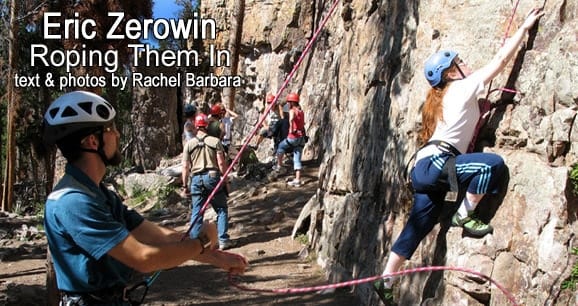 Stuck between a rock and a hard place? Not even close.
Stuck between a rock and a hard place? Not even close.
Climbing guide Eric Zerowin sets anchors high above the shores of Lake Dillon as his two guests absorb the views. The late-morning sun shines brightly in the blue sky, and it’s too early in the day for summer’s afternoon showers to begin rolling in. A cool breeze, common for 9,200 feet, sweeps across the lake.
“Even though that tree is dead, can it support our weight?” asks one of the guests.
Obviously not new to the question, Zerowin, a guide for Colorado Bike and Ski Tours, continues setting anchors as he explains that even dead trees have super strong root systems. He details Colorado’s pine beetle situation and pushes against a dead tree with all his body weight.

“See, it’s not going anywhere,” says Zerowin. “And since we anchor to the base, it’s even stronger.”
He explains that he’s setting three separate and equally strong anchors, so that even if two were to fail, everyone’s weight still would be supported.
As a guide, Zerowin has faced plenty of questions regarding the ropes, how much weight they can hold, why all the trees are dead and so on. After one of his recent trips, he agreed to answer some of our questions, as well.
The rope you used to tie one of your anchors couldn’t be more than a half-inch in diameter. How much weight can it really hold?
It’s rated for at least 2,000 pounds. The climbing rope is rated to the 4,000-pound range.
Is this what you do every day?
Climbing is not the only thing I do. I guide cycling and hiking, and I’m also one of the guides for our corporate team-building programs. Basically, I’m in charge of all the equipment.
Tell me about your standard climbing trip.
A regular climbing trip is typically a smaller group, family or friends. We take them out for approximately four hours and we have them climb outdoors on top rope routes. Most of the people that come out are completely inexperienced, and it’s a big deal for them to get outdoors and climb on a real rock, as opposed to a climbing gym, where some have climbed before.
What do you mean by top rope routes?
Top roping, which is what we do for our customers, is when you can easily access the top of the cliff, whether it be by hiking or climbing a route that is very safe and easy. You set up an anchor at the top and throw the rope over the edge to the bottom.
But, when you do a traditional lead climb, both the first climber and the second climber are at the base. As the lead climber goes up, he has to put pieces of gear into the rock face to clip the rope to. That creates the anchor that would hold you if you were to fall.
Multi-pitch means that you end up climbing more than one rope length away from the ground. A rope length is typically about 160 feet. With some multi-pitch climbs you end up climbing 300-plus feet above the ground.

Have you ever been in any sketchy situations, privately or professionally?
I used to climb multi-pitch traditional routes in the Gunks, in New York. We were doing a climb so tall that we had to do a multiple rappel to get to the ground. And when we went to pull our rope down it got stuck. So we were not on the ground yet, but our rope was stuck above us in some unknown way.
We considered climbing the rope, but we didn’t know how it was stuck, and that could be a risky proposition, because you could get up the rope and then it could break free and you could fall. We decided that wasn’t a very smart option. So we yelled for help, and fortunately we had other friends climbing in the vicinity.
They heard us, and we were able to use some of the other equipment we had to hoist up their climbing rope, which we borrowed to rappel to the ground. And then we hiked up the easy route that took us to the top of the cliff, and retrieved our rope from the top. It wasn’t very scary, it was just a pain in the butt because we were kind of trapped.
Since you’re always looking up, do you get to see a lot of good butts?
Yeah, a couple.
How did you end up with the skills to not just climb, but to be a guide, someone who beginners entrust their lives with?
Through years of experience and practice. Most people who are comfortable climbing on their own, or with friends or family, they probably have enough knowledge to set up an anchor system to properly secure people they don’t know. But having the right attitude and demeanor with customers builds trust. I began instructing as a counselor at scout camp. I was in charge of the climbing wall there when I was 16 years old. The first time I ever climbed, I was 13. I’m 30 and nine twelfths.
What’s your favorite part of the job?
Seeing the excitement in anybody from a 4-year-old kid to a 45-year-old parent that’s there with their kids; and seeing the excitement they get out of trying something that’s above their typical comfort level. It may be something that they never tried before, or that thrill of being off the ground and being in a beautiful location and doing something they don’t normally do.
If You Go
Colorado Bike and Ski Tours
www.coloradobikeandski.com
From the Editors: We spent a heap of time making sure this story was accurate when it was published, but of course, things can change. Please confirm the details before setting out in our great Centennial State.

